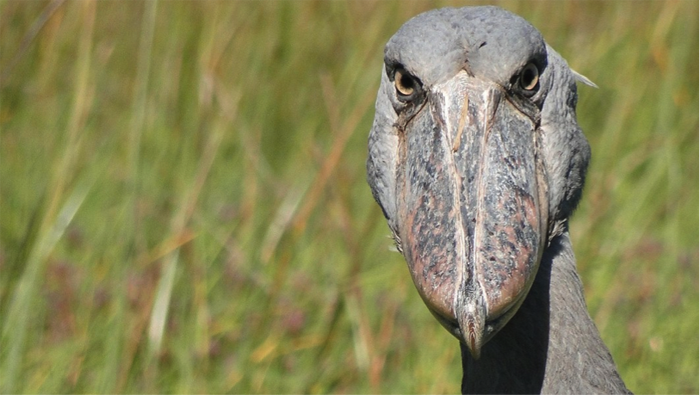The Shoebill stork belongs to the list of the most sought after birds by tourists in Uganda!
The Shoebill stork is one the most sought after birds in Uganda
What does the shoebill stork look like – This gigantic stork appears on the birders’ list of most sought for birds in Africa or Uganda in particular. It’s a large grey stork with a dinosaur-like presence when seen standing from a distance. “Shoebill stork” – this bird is called so after its shoe-like bill that grows to a distance of 26cm. These birds heavy though can stand quietly on floating vegetation and pouch to glean catfish. In Uganda the shoebill stork can be tracked in Mabamba Swamp, Murchison falls in the Albertine region, in captivity at UWEC (Uganda Wildlife Education Center), Rugogo swamp in Ziwa Rhino Sanctuary, Lake Mburo National park, Semuliki National park among other places.
Classification of the shoebill stork
Kingdom: Animalia
Phylum: Chordata
Class: Aves
Order: Pelecaniformes
Family: Balaenicipitidae
Genus: Balaeniceps
Species: Balaenicepe rex
Scientific Name of the shoebill stork: Balaenicepe rex
Reproduction of the shoebill stork
Shoebill storks are solitary, they build their nests distant. During the breeding season, both parents pair up to defend their territory/range. They mainly nest after the wet season. Both parents get active when building the nest. During nesting, shoebills clear an area of approximate 3 meters. The shoebills usually raise one chick though they may hatch more. Shoebills take approximately 3 years before attaining sexual maturity.
Food Habits of the shoebill stork
They eat fish and floating water vegetation. This is why they love waters with less oxygen where fish show up to breath. Muddy waters, also make a fitting environment for shoebill feeding. They launch a quick and violent attack on their prey. However, Hippos movements also benefit shoebills as they usually force fish to surface while moving underwater. Shoebills feed on Senegal Bichir Marbled Lungfish, Tilapia, and Catfish, among others. Other prey eaten by Shoebill include; frogs, young Nile Monitors, young crocodiles, and water snakes. They also feed on snails, turtles, and rodents.
IUCN Report on the shoebill stork
Vulnerable
Contribution to the Eco – System of the shoebill stork
Population control invertebrates
Life Span of the shoebill stork
They live up to 36 years in the wild but even longer in captivity
Predators of the shoebill stork
Large snakes and human activities that cause loss of habitat.
Birders seeking to organize unique Birding tours in Uganda should contact our reservations team for inquiries. We pledge to prepare and guide you on a life-changing wildlife safari/tour in any of Uganda’s incredibly endowed Nationals parks. To book a safari or make inquiries, simply send us an email to info@raksafaris.com or call us now on +256-782 061184 to speak with our reservations team.




